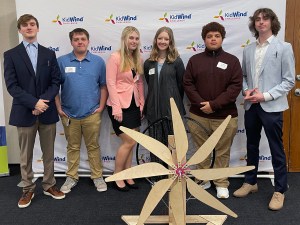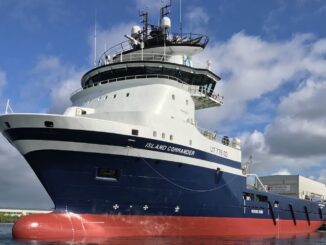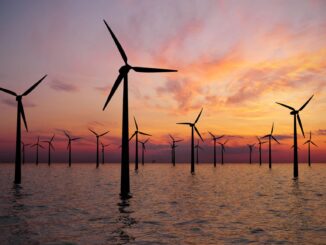
It has been quite a whirlwind month for Lindsey Greer.
Just as her team from Virginia’s Smithfield High School was snagging an award at the 8th annual National KidWind Challenge, the 17-year-old senior found out she had won a $5,000 college scholarship from the Business Network for Offshore Wind.
Greer, who graduates next month, plans to attend James Madison University this fall to study engineering, which she anticipates will be her launchpad to design the next generation of offshore wind turbines. The Harrisonburg school is selected regularly to participate in the esteemed U.S. Department of Energy’s Collegiate Wind Competition.
Her six-member high school team from the Hampton Roads region, The Goon Squad, was one of 82 that faced off this month at the University of Colorado. Students from elementary, middle and high schools earned points via contests that included testing their small-scale model turbines in wind tunnels and explaining their thinking to judges.
“We love the movie ‘The Goonies,’” Greer said about her team’s namesake. “And we’re pretty goofy.”
Greer and her fellow wind whizzes won a special award in the “Fixed Bottom Offshore Wind Challenge” category. Fittingly, teams constructed a fixed bottom foundation in a fake ocean and tested it in a wind tunnel.
Sign up for Energy News Weekly
Get the most important energy news of the week delivered directly to your inbox.
“It’s a replica of what Dominion Energy does offshore,” she said. “We used a sand screw, PVC pipes, 3D-printed supports, and our usual hub and blade design.”
Greer is one of three recipients of the business network’s Rising Star Offshore Wind Student Scholarship, which was initiated last year. The two other winners are from Newport, Rhode Island; and Portsmouth, New Hampshire. The nonprofit educational organization has offices in several East Coast states.
Virginia sent half a dozen teams to KidWind in Boulder. One was the AirBenders, also from Smithfield High School. Team J.A.M.S., also of Smithfield, was named a top performer in the middle school division. Another Virginia top performer, in the high school division, was the Tabb High School Wind Breakers of Yorktown.
Greer will continue to savor KidWind memories after she receives her diploma on June 16. And, no doubt, she will be deploying some of that know-how in her freshman engineering classes this autumn.
“Once you get started, it’s hard to stop,” she said about the joy of contributing to a creative team. “It’s almost like you’re addicted to it. There are lots of ups and downs and the highs are definitely worth it.”
In an interview with the Energy News Network, Greer elaborated on her commitment to offshore wind. This conversation was lightly edited for clarity and length.
Q: What do you want to tell readers about your team, The Goon Squad?
A: We had the greatest time. Our team had two juniors and four seniors and I’ve known a good portion of them since elementary school. It’s definitely a lot better to have a team because when something goes wrong, someone is there to try to fix it.
Competition can be stiff and communication can be complicated. Our approach is to divide and conquer. We’re playful, but I’m fortunate that this group knows when it’s time to get serious, lock in and get things done.
Q: What’s your specialty with the team?
A: This year, I was in charge of the blades on our model. We ran through a lot of birch wood because we experimented with six or seven types of blades, trying different lengths and widths.
Fortunately, birch is not in high demand, and the manufacturing and engineering program has access to a lot of supplies. Our school is very kind to us.
Q: What sparked your interest in wind energy?
A: During my freshman year, my engineering exploration class included a brief lesson about the wind industry. My teacher was my mom.
I learned about the KidWind competition and thought, “Hey, I can do this.” We had a team of three girls in 2020; two were seniors. Our project had a wooden base, blades made of PVC pipe, and an old bike wheel as part of the pulley system. We advanced from the regional level, but the pandemic canceled the state and national competition that year.
In 2021, we competed digitally and only at the national level because of the pandemic. I didn’t compete last year because I had a heavy load of college-level courses.
Q: Wait, so your mother, Heather Greer, teaches your engineering class and coaches the wind energy teams?
A: Yes, she started out as a biology teacher. Now, she teaches engineering and Adam Shipman, our other coach, teaches manufacturing. My mom has had our school competing in KidWind since 2018. She’s an inspiration.
We’re lucky to have them in this program because they open us up to so many ideas and are always there with whatever we need. They invite professionals from Dominion Energy, James Madison University and engineering firms to our school to help introduce us to concepts and things we’ll see when we get into the business.
The best part about their coaching is that they don’t tell us what we should do with competition projects. They let us fail and figure out what the next step should be.
They’re always trying to find ways to make us succeed and push us to the limit, in the most gentle way possible.
Q: How did wind power become such a “thing” in Smithfield? Is it at all connected to the Coastal Virginia Offshore Wind project that Dominion Energy is constructing relatively close by?
A: That’s part of it. My dad is a mechanical engineer in Portsmouth and my whole family is involved in engineering. And a lot of our residents have somebody in their family involved with energy or renewable energy.
Q: What kind of time commitment is a KidWind project?
A: I don’t know the number of hours this year, but including all three competitions — state, regional and national — it’s got to be up there. We spent two classes a day working on it and also time after school.
We’re thinking about the project and how we can make it better 24/7 because when something goes wrong we know we have to come up with a solution as quickly as possible. There are several instances where I wake up in the middle of the night thinking, hey, what if we …?
Q: Why did you choose to attend James Madison University in the Shenandoah Valley, which is definitely not coastal Virginia?
A: I got a good look at the campus because it hosted the state competition for KidWind. I have toured its Center for Advancement of Sustainable Energy and it was eye-opening to see details about the wind industry.
Their engineering program is general, meaning I’ll have a little taste of all types of engineering. So, in graduate school, I’ll know where I want to specialize. It seems to be hands-on based, which matters to me because I’m not a person who wants to be staring at words all day.
Q: Was there anything particularly difficult about this year’s competition in Boulder?
A: Well, because of a mix-up we ended up going to Martinsville, Virginia, which is about six or seven hours away, for the regional competition.
Then, we had three weeks to redesign something we knew we had to pack on an airplane. That time crunch meant we went with something we knew worked.
Our base was PVC pipe and we laser-cut the blades from birch wood. The whole turbine had a lot of 3-D printed parts that are adjustable and replaceable.
Q: You mentioned that you learned to “fail fast, reiterate fast and take failures as lessons.” How does that mantra tie into wind competitions?
A: Often, so many ideas we thought were top-of-the-line would just fail. Our coaches helped us realize that the longer you sit there and dwell on what went wrong, you lose time figuring out how to make it right.
That’s true for engineering and anything else in life.



